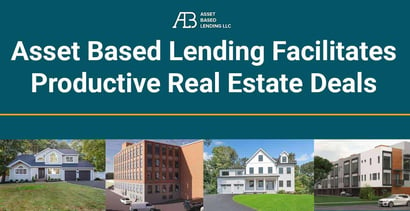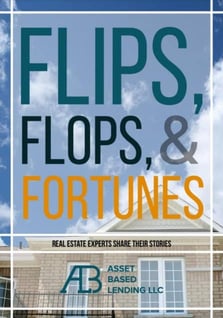
In a Nutshell: Investors looking to purchase, renovate, build, or refinance single-family, multifamily, and mixed-use properties understand that real estate investment is a block-by-block business that moves quickly. Traditional lenders can’t manage these dynamic environments because they tend to shy away from uncertainty. Asset Based Lending embraces them — within reason. Asset Based Lending has emerged as a leading hard-money lender combining a flexible, relationship-based approach with reliability and professionalism. In 36 US states and growing, investors rely on Asset Based Lending to drive results-oriented deals on short timelines.
There’s a joke in the financial industry that hard money lending — funding secured by real property — is the world’s second-oldest profession. Long before the complexities of modern finance evolved, borrowing against assets was the only way to obtain credit.
Think of ancient Mesopotamian farmers buying seeds on credit and sharing the resulting crops to repay the loans.
It’s a specialized category today, one that is evolving and maturing — some might say professionalizing — thanks to Asset Based Lending, a hard money lender with origins in New Jersey. Asset Based Lending provides fast bridge financing to real estate investors looking to purchase, renovate, build, or refinance single-family, multifamily, and mixed-use properties.
Differentiators are service and transparency to get loans done on timelines that traditional mortgage lenders can’t achieve. Not that they’re trying to match what Asset Based Lending can do.

Chief Marketing Officer Eric Krattenstein said traditional lending takes a higher-level, longer-term view of the marketplace to serve residential property owners. In contrast, the team at Asset Based Lending is local in 36 states and always ready to close deals for fast-moving fix-and-flip investors. These deals require looking at the market at a hyperlocal level.
“There’s no such thing as a lender who knows New Jersey,” Krattenstein said. “You don’t even know Newark or Jersey City because when you go three blocks in one direction, you’ve got a very different market than where you started.”
That’s the inherent flaw in a big national lending operation where an underwriter in California does a desktop valuation on a deal in southside Newark without understanding street dynamics. Asset Based Lending combines a boots-on-the-ground team approach with relationship-driven underwriting to meet the moment.
“That’s in our company’s DNA,” Krattenstein said. “When we started in 2010, we knew New Jersey markets inside and out, block by block. We’ve just expanded our reach.”
A Hard Money Lender in Growth Mode
That start in New Jersey coincided with the global financial crisis of 2007-08 when three financial industry veterans found themselves looking for opportunities. They formed a boutique hard money lender to utilize their experience, institutional background, and network to professionalize an industry that had historically been like the Wild West.
“The industry’s come a long way since then, but hard money lending still gets a bad rap,” Krattenstein said. “The mandate from the beginning was to be transparent and professional and show people why that shouldn’t be the case.”
The company started as a small fund with the investors as the partners. Distinguishing the firm in those days was that the partners lent their own money.

To an extent, that still holds today. Asset Based Lending continues to run its balance sheet, lending based on about $100 million in capital. It closed a $150 million in securitization in 2023.
That’s not typical with lenders of any size. Institutional capital and borrowed money provide impetus in most scenarios.
“That’s also part of our DNA,” Krattenstein said. “We ask whether we’d be comfortable if some of the money for a deal came from a parent or sister. That mentality has always dictated how we approach projects and relationships.”
A private equity firm acquired the original fund about two years ago and converted it into a balance sheet transfer lender. Asset Based Lending’s philosophy and business approach remain, only on a much larger scale.
Sizable competitors have dropped out as the market has grown more volatile. Asset Based Lending has acquired customers from those dissolutions to position itself for continued growth.
“We funded about 1,230 loans for $550 million in 2023,” Krattenstein said. “Moving forward, it’s more of the same, just bigger, more effective, more efficient, and all over the country.”
Relationship-Driven Underwriting Provides Flexibility
Asset Based Lending distinguishes itself in today’s volatile market by sticking to the plan.
“The reality of what sets us apart is sort of a silly thing to talk about because everybody says it — it’s service, transparency, and professionalism,” Krattenstein said. “Borrowers trust that we’re going to do what we say we’re going to do, and we’re going to close on time.”
Getting there requires doing what alienates traditional bank lenders: building relationships and being there when it’s time to pull the trigger.

Real estate deals come and go in a matter of hours or days. Banks need 60 to 90 days to close. Borrowers can count on Asset Based Lending to complete deals in a week or two.
They also rely on Asset Based Lending to go beyond the numbers and fund loans for borrowers who may not have pristine credit. While the average client credit score is well above 700, the firm supports many borrowers with scores in the fives and sixes.
These investors value speed and transaction ease. They need products built for investors. They’re not interested in being shoehorned into conventional bank loans or jumping through hoops.
Asset Based Lending usually offers 12- to 18-month interest-only deals for purchase and renovation. Borrowers then sell the properties to pay off the loans or refinance if they plan to retain and rent them.
First-timers are welcome, but Asset Based Lending caps first-timer loans at $350,000.
“The combination of our sales team being very consultative and the underwriter actually speaking with the borrower, reviewing the loan upfront, and really getting into the weeds, lets us get comfortable assessing the risk,” Krattenstein said. “We want to ease you into it.”
Risk-Adjusted Returns for Sound Planners
The payoff for first-time borrowers is a chance to build a lucrative fix-and-flip career. Like Mesopotamian crop yields, the returns are worth it.
“It’s fantastic to lend to a first-time investor, and then a couple of years later, they quit their W-2 job to do this full time,” Krattenstein said. “They still borrow from us, but now they’re doing 10 deals a year.”
None of that means Asset Based Lending jumps in without understanding the lay of the land. Hard money loans are generally more expensive than traditional mortgages. The company supports investors who may carry substantial debt. It finances based on a speculative assessment of a property’s future value.
But it’s a promise-keeper at closing time. The team will send prospective borrowers back to the drawing board if they signal a lack of preparation.
“Understand the details of your project — don’t approach any lender with only a high-level understanding of what you’re trying to do,” Krattenstein said. “Have a plan in mind for how you’re going to execute this thing, get out of the loan in 12 months or less, and make money.”
Asset Based Lending operates under a unique profitability rule that prohibits deals unless calculations tell the team that the borrower will recoup a certain amount. That rule holds even when the borrower is willing to accept less return. The firm does not want borrowers to face situations where delays or cost increases cause them to go negative.
That’s why it makes moves only when conditions warrant. It may not win on interest rate, but it always wins regarding oversight, reliability, and flexibility. Borrowers enter into partnerships with a long-term vision.
“We want investors to succeed and become repeat investors,” Krattenstein said. “Most of our business comes from returning borrowers. We’re offering a path toward the American Dream.”






